Sexing Cockatiels
Some of the things to take into account when visually sexing cockatiels are the age of the bird and the colour of the bird. I will go through some of the more common colours and with the help of pictures explain how it is possible to tell the sexes apart.

Cockatiels are what is termed as ‘dimorphic’ meaning in most cases there are visual differences between the sexes making it easy to tell them apart. The exception to the rule is the Pied mutation which is referred to as an anti-dimporphic mutation because the usual differences between the sexes do not apply.
All cockatiel chicks when they first get their feathers will look like a female. There are no exceptions to this rule and they will stay that colour until they go through their adult moult at around 6 – 9 months of age.
As a result they cannot be visually sexed using pictures under 6 months of age!
As adults there are a few things that differ between the sexes
- Face colour
- Spotting under the wings
- Stripes and barring on rump and under tail
- Behaviour and Vocalizations
Other methods of sexing:
- sexable nests,
- DNA sexing and
- pelvic sexing.
Face colour
The easiest and most obvious difference between the sexes in solid coloured birds ie. normal grey, cinnamon etc is the face colour. Males will get a yellow face when mature in normal cheek birds and in whiteface birds they get a white face. This change appears when they go through their adult moult at around 6 – 9 months of age.
This picture shows a 6 month old male moulting in his yellow face. Some grey juvenile feathers still remain as it goes through the transition from juvenile feathering to adult plumage.

Wingspots

Wingspot sexing is similar in all mutations except for pearl, pied and sometimes lutino and the multi-mutations of these birds. This rule applies to all solid coloured birds whose colour is a result of colour changing genes. This will not be reliable with birds of visual pattern altering genes such as pearl and pied. The Pied mutation is technically ADM Pied which means this gene removes the difference that is normally noticeable between the sexes. For more information on the pied please see my Pied Cockatiel page. With Lutino and Whiteface Lutino birds the spots are often there but because of the lack of contrasting colour are very difficult to see. It is possible with a black light but not everyone has access to one of those.
Wingspots are the spots on the underside of the primary and secondary flight feathers. Males will usually have spots on only the outer feathers furthest from the body or he will have none at all. A hen will have spots on all the feathers from the body right out to the longest flights. A juvenile bird usually has spots on all the feathers the same as a hen and moults out these at around 6 months of age when they are replaced by non-spotted feathers.
All juveile birds have a stripe pattern on the rump area and the tail feathers have striping or barring. This is hard to see in lutinos and whiteface lutinos due to lack of any contrasting colour. Once again pieds do not have this if they have a lot of white or yellow feathering. Hens will retain this barring throughout their life but males will moult in solid coloured feathers as they mature.
Below is a picture of a male moulting in solid coloured feathers on the rump and the second picture shows an adult hen with the retained barring.


Behaviour

One behaviour that differs between the sexes is the male displays what is commonly called ‘heart wings’. This means he spereads the wings at the should away from his body and the wingtips cross over around the rump area. This is usually accompanied by vocalising and strutting back and forth along the perch. It is a common habit that is used to attract a mate.
Sexing your birds can be made easier by some careful observation of their behaviour. Young males will start to show tell tale signs of the first throaty whistles at quite a young age, but it is easy to miss if you aren’t watching. It is best to observe them from a distance and don’t stare at them or they will stop doing it. If you can’t tell which one is making the noise look at their tails for slight movement in time with the whistle.
Other methods of sexing
Sexable Nests
It is possible to sex very young cockatiels by other metods. The most reliable and 100% guaranteed method is by a sexable nest. That means the parents are selectively paired to give chicks of a particular colour that will be a known sex. This only works with sex-linked mutations such as pearls, platinums, cinnamons and lutinos and does not work with all pairings of these types either.
I have 2 pairs that give me 100% sexable nests and it is perfect for when we handraise babies as pets.
Whiteface Pearl split Platinum male & Whiteface Platinum hen
- Whiteface platinum pearl females
- Whiteface pearl females
- Whiteface males
- Whiteface Platinum males.
Because dad is pearl and mum is not he will pass pearl onto every baby regardless of sex but because male chicks need pearl from mum and dad to be visually pearl, they will only be split pearl whereas every female chick will show the pearl visually.
Whiteface Platino split Pearl male & Pastelface Pearl hen
- Whiteface pearl platinum or lutino females
- Pastelface platinum or lutino females
- Whiteface or whiteface pearl males
- Pastelface or pastelface Pearl males.
Because dad is platino (platinum lutino) and mum is not he will pass either platinum or lutino onto every baby regardless of sex but because male chicks need that colour from mum and dad to be visual , they will only be split platinum or lutino whereas every female chick will show one of these 2 colours visually.
DNA Sexing
DNA sexing in cockatiels is a non-invasive method used to determine the sex of a bird by analyzing its DNA. Unlike visual sexing, which relies on external physical characteristics (such as color and markings), DNA sexing involves taking a small sample of the bird’s tissue, typically from a feather or blood sample. This sample is then analyzed in a laboratory to identify the sex chromosomes present. Female cockatiels have two Z chromosomes (ZZ), while males have one Z and one W chromosome (ZW). I have previously referred to these chromosomes as XX or XY because that is what most people are used to.
Pelvic Sexing
Pelvic sexing is a physical method used to determine the sex of cockatiels by examining the shape and structure of their pelvic bones. This technique involves gently palpating (feeling) the bird’s abdomen to assess the distance and width between the pelvic bones. In male cockatiels, the pelvic bones are typically closer together and more rigid and pointed, while in females, the pelvic bones are wider apart and more rounded to accommodate egg-laying. While pelvic sexing can be effective in adult birds, it can be more challenging in younger cockatiels or those that aren’t fully matured, as their pelvic bones may not be as distinguishable. Additionally, while this method can be accurate, it requires skill to ensure accurate results and minimize injury to the bird.
Pictures of different sexes
Below are pictures of some of the different mutations showing a male, female and juvenile.






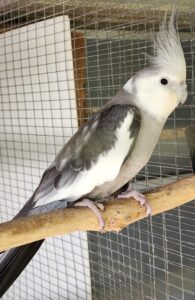



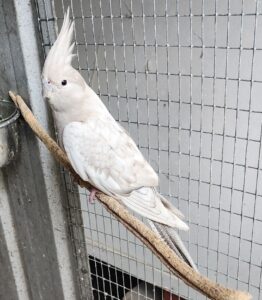


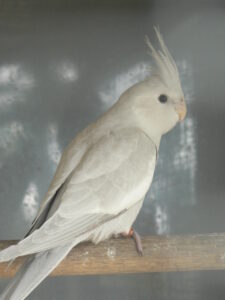
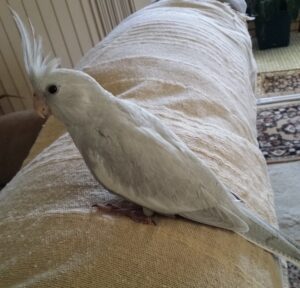

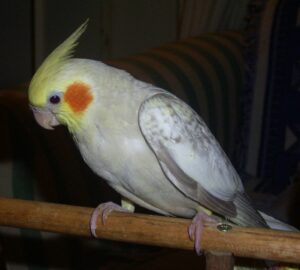



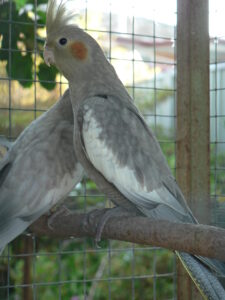
Reach Out To Us
Interested in adding a new feathered family member or learning more? Reach out to us by clicking on the button below.